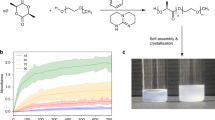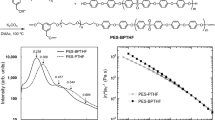Abstract
We investigated the microphase separation behavior of well-defined poly(arylene ether sulfone)-b-polylactide (PES-b-PLA) diblock copolymers. PES was synthesized by the nucleophilic aromatic substitution polymerization of 4-fluoro-4′-hydroxydiphenyl sulfone potassium salt in the presence of an allyl-functionalized initiator, which follows a chain growth condensation polymerization mechanism. A hydroxyl group installed via a thiol-ene reaction was utilized as the initiating site for the ring opening polymerization of d,l-lactide, producing the target polymer. The polymers were further purified by preparative size-exclusion chromatography and analyzed by small-angle X-ray scattering with temperature variations from room temperature to 150 °C. The PES block was glassy in the employed temperature range, but the PLA chains provided sufficient mobility for ordering of the block copolymer when PES was the minor fraction. An order-disorder transition (ODT) with changing temperature could not be located because PLA was not stable above 170 °C. From the degree of polymerization values of the polymers near the ODT, the Flory–Huggins interaction parameter, χ, could be roughly estimated as 0.12 at 150 °C. This high χ value suggests that engineering plastic-containing block copolymers could be useful in advanced lithographic and filtration applications.
This is a preview of subscription content, access via your institution
Access options
Subscribe to this journal
Receive 12 print issues and online access
$259.00 per year
only $21.58 per issue
Buy this article
- Purchase on Springer Link
- Instant access to full article PDF
Prices may be subject to local taxes which are calculated during checkout







Similar content being viewed by others
References
Bates FS, Fredrickson GH. Block copolymers-designer soft materials. Phys Today. 1999;52:32–8.
Sinturel C, Bates FS, Hillmyer MA. High χ−low N block polymers: how far can we go? ACS Macro Lett. 2015;4:1044–50.
Bates CM, Maher MJ, Janes DW, Ellison CJ, Willson CG. Block copolymer lithography. Macromolecules. 2014;45:2–12.
Jackson EA, Hillmyer MA. Nanoporous membranes derived from block copolymers: from drug delivery to water filtration. ACS Nano. 2010;4:3548–53.
Ahn H, Park S, Kim S-W, Yoo PJ, Ryu DY, Russell TP. Nanoporous block copolymer membranes for ultrafiltration: a simple approach to size tunability. ACS Nano. 2014;8:11745–52.
Bernaerts KV, Du Prez FE. Dual/heterofunctional initiators for the combination of mechanistically distinct polymerization techniques. Prog Polym Sci. 2006;31:671–722.
Karunakaran M, Nunes SP, Qiu X, Yu H, Peinemann K-V. Isoporous PS-b-PEO ultrafiltration membranes via self-assembly and water-induced phase separation. J Membr Sci. 2014;435:471–7.
Rasappa S, Shulte L, Borah D, Morris MA, Ndoni S. Rapid, brushless self-assembly of a PS-b-PDMS block copolymer for nanolithography. Colloids Interface Sci Commun. 2014;2:1–5.
Yokozawa T, Yokoyama A. Chain-growth condensation polymerization for the synthesis of well-defined condensation polymers and π-conjugated polymers. Chem Rev. 2009;109:5595–619.
Yokozawa T, Asai T, Sugi R, Ishigooka S, Hiraoka S. Chain-growth polycondensation for nonbiological polyamides of defined architecture. J Am Chem Soc. 2000;122:8313–4.
Suzuki Y, Hiraoka S, Yokoyama A, Yokozawa T. Chain-growth polycondensation for aromatic polyethers with low polydispersities: living polymerization nature in polycondensation. Macromolecules. 2003;36:4756–65.
Park J, Moon M, Seo M, Choi H, Kim SY. Well-defined star-shaped rod-coil diblock copolymers as a new class of unimolecular micelles: encapsulation of guests and thermoresponsive phase transition. Macromolecules. 2010;43:8304–13.
Park J, Seo M, Choi H, Kim SY. Synthesis and physical gelation induced by self-assembly of well-defined poly(arylene ether sulfone)s with various numbers of arms. Polym Chem. 2011;2:1174–9.
Yokozawa T, Taniguchi T, Suzuki Y, Yokoyama A. Chain-growth polycondensation of monomer consisting of two aromatic rings: synthesis of well-defined poly(ether sulfone) from 4-fluoro-4′-hydroxydiphenyl sulfone. J Polym Sci Part A: Polym Chem. 2002;20:3460–4.
Cotter RJ, Engineering Plastics: a Handbook of Polyarylethers. Gordon and Breach Publishers; 1995.
Lee J, Park J, Oh J, Lee S, Kim SY, Seo M. Nanoporous poly(ether sulfone) from polylactide-b-poly(ether sulfone)-b-polylactide precursor. Polymer. 2019;180:121704.
Lee J, Lee B, Park J, Oh J, Kim T, Seo M, et al. Synthesis and phase transition behavior of well-defined poly(arylene ether sulfone)s by chain growth condensation polymerization in organic media. Polymer. 2018;153:430–7.
Kennemur JG, Hillmyer MA, Bates FS. Synthesis, thermodynamics, and dynamics of poly(4-tert-butylstyrene-b-methyl methacrylate). Macromolecules. 2012;45:7228–36.
Maurer WW, Bates FS, Lodge TP. Can a single function for χ account for block copolymer and homopolymer blend phase behavior? J Chem Phys. 1998;108:2989–3000.
Matsen MW. Phase behavior of block copolymer/homopolymer blends. Macromolecules. 1995;28:5765–73.
Acknowledgements
This research was supported by the National Research Foundation of Korea (NRF) grant funded by the Korea government (MSIT) (No. 2018R1A5A1025208) and the Climate Change Research Hub of KAIST (Grant No. N01140053). JL and MS also acknowledge financial support from the BK21Plus Program through the NRF funded by the Ministry of Education of Korea. The experiments at Pohang Accelerator Laboratory (PAL) were supported in part by the Ministry of Science and ICT of Korea and POSTECH. TEM imaging was conducted at the Korea National NanoFab Center, which is supported by the Nano Material Technology Development Program through the National Research Foundation of Korea (NRF) funded by the Ministry of Science and ICT (2009–0082580).
Author information
Authors and Affiliations
Corresponding author
Ethics declarations
Conflict of interest
The authors declare that they have no conflict of interest.
Additional information
Publisher’s note Springer Nature remains neutral with regard to jurisdictional claims in published maps and institutional affiliations.
Supplementary information
Rights and permissions
About this article
Cite this article
Lee, J., Park, J. & Seo, M. Well-defined poly(ether sulfone)-b-polylactide: synthesis and microphase separation behavior. Polym J 52, 111–118 (2020). https://doi.org/10.1038/s41428-019-0268-2
Received:
Revised:
Accepted:
Published:
Issue Date:
DOI: https://doi.org/10.1038/s41428-019-0268-2
This article is cited by
-
Poly(ether sulfone)-based ultrafiltration membranes using chitosan/ammonium chloride to enhance permeability and antifouling properties
Polymer Journal (2022)
-
Enzyme-catalyzed propagation of cello-oligosaccharide chains from bifunctional oligomeric primers for the preparation of block co-oligomers and their crystalline assemblies
Polymer Journal (2021)



